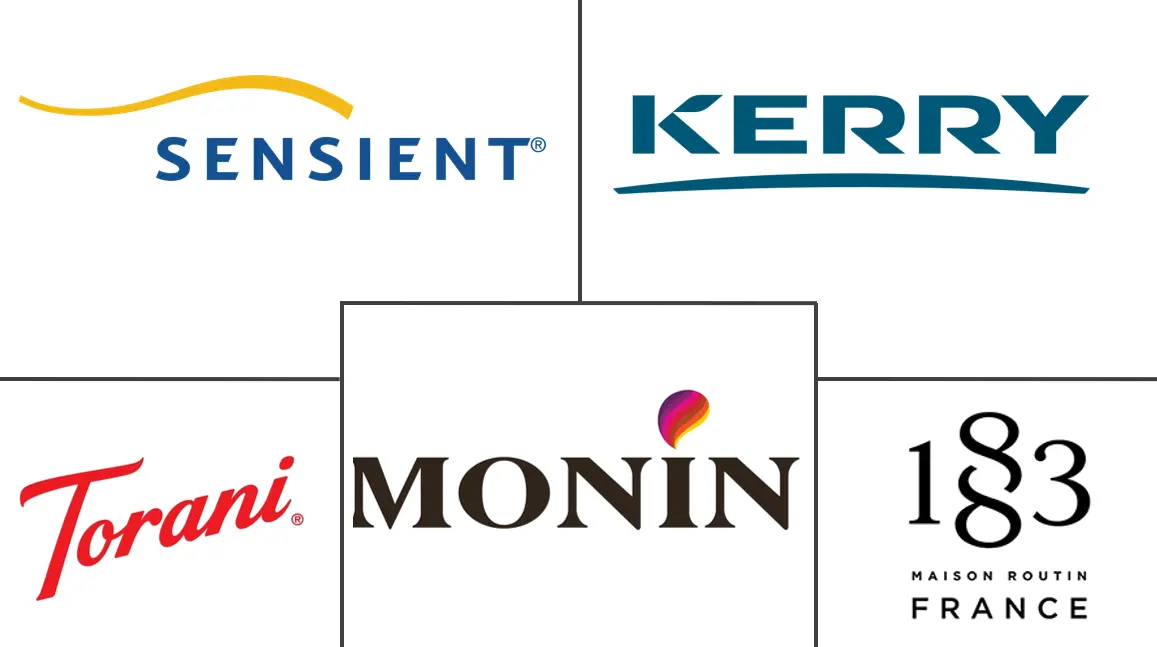Flavored Syrups Market Size and Share
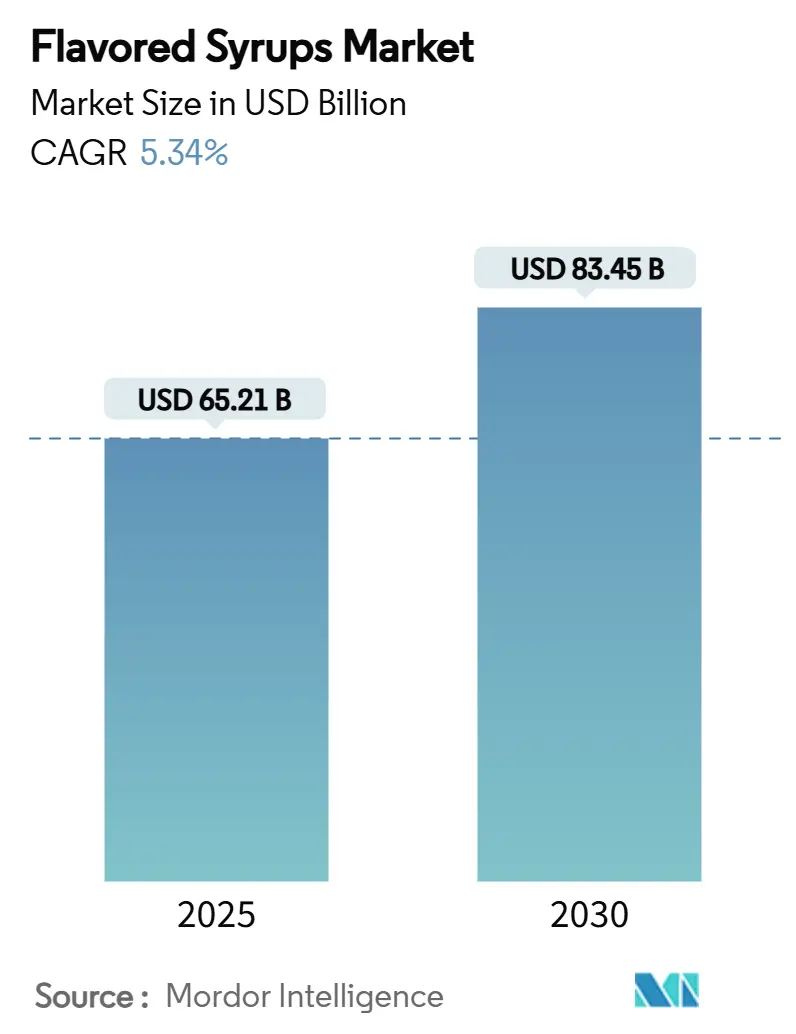
Flavored Syrups Market Analysis by Mordor Intelligence
The global flavored syrups market size reached USD 65.21 billion in 2025 and is projected to climb to USD 83.45 billion by 2030, reflecting a 5.34% CAGR. Robust growth stems from the sector’s transition from commodity sweeteners to premium, customizable taste solutions that command healthier margins across both retail and food-service channels. Heightened consumer interest in clean-label, plant-based and low-sugar profiles is accelerating formulation innovation, while AI-assisted R&D shortens development cycles and curbs costs. Supply-chain resilience around vanilla and citrus oils remains a differentiator as climate risks and tariff structures squeeze smaller players. Geographic expansion, particularly in Asia-Pacific, underlines the industry’s capacity to replicate North America’s premium coffee culture while tailoring flavors to local palates.
Key Report Takeaways
- By product type, fruit syrups led with a 35.56% flavored syrups market share in 2024, yet botanicals and herbals are forecast to grow fastest at a 7.89% CAGR through 2030, especially in Europe and North America.
- By application, beverages held 36.50% of the flavored syrups market in 2024, while functional foods are projected to register a 6.34% CAGR from 2025–2030, most rapidly in Asia-Pacific.
- By distribution channel, B2B/food-service controlled 54.23% of the 2024 share; B2C e-commerce is poised for a 7.12% CAGR on the back of direct-to-consumer premium bundles in North America and Europe.
- By geography, North America commanded a 34.56% share in 2024, whereas Asia-Pacific is anticipated to post the highest regional CAGR of 6.45% by 2030.
Global Flavored Syrups Market Trends and Insights
Drivers Impact Analysis
| Drivers | (~) % Impact on CAGR Forecasts | Geographic Reevance | Impact Timeline |
|---|---|---|---|
| Rising demand for premium and customizable flavor experiences | +1.2% | Global, with concentration in North America & Europe | Medium term (2-4 years) |
| Continuous innovation in syrup formulations | +0.8% | Global, led by North America & Asia-Pacific | Long term (≥ 4 years) |
| Increasing consumer interest in natural, plant-based, and clean-label products | +1.0% | North America & Europe primarily, expanding to Asia-Pacific | Medium term (2-4 years) |
| Growing demand for low/no-sugar and health-oriented syrup options | +0.9% | Global, strongest in developed markets | Medium term (2-4 years) |
| Influence of culinary tourism and global cuisine trends | +0.6% | Global, with early adoption in urban centers | Long term (≥ 4 years) |
| Increasing expansion in foodservice sectors | +0.7% | Asia-Pacific core, spill-over to MEA | Short term (≤ 2 years) |
| Source: Mordor Intelligence | |||
Rising Demand for Premium and Customizable Flavor Experiences
In the flavored syrups market, operators are increasingly turning to premium positioning as their main strategy for value creation. By emphasizing customization, they're managing to push their profit margins beyond the limits of traditional commodity pricing. Monin has strategically named Yuzu its "Flavor of the Year" for 2025, riding on a notable 30% growth in menu presence for this citrus over the past four years. Monin forecasts Yuzu will outshine 96% of other flavors by 2028. Meanwhile, Torani is broadening the horizons of premiumization. Their introduction of Kettle Corn syrup taps into the emerging trend of "Sweet and..." flavor combinations, merging sweetness with unconventional profiles for unique experiences. While the push for customization adds layers of operational complexity, it also paves the way for higher profit margins. This is evident as foodservice operators champion premium beverage selections, bolstering their profit margins even if beverages constitute a minor slice of total sales. On the tech front, innovations like Coca-Cola's Freestyle and Pepsi's Spire systems are revolutionizing dispensing technology. These advancements not only enable mass customization but also uphold operational efficiency, granting a sustainable edge to those who adopt them early.
Continuous Innovation in Syrup Formulations
Formulation innovation has evolved from mere tweaks to comprehensive overhauls, simultaneously tackling regulatory compliance, health positioning, and sustainability mandates. A case in point: the FDA's [1]U.S. Food and Drug Administration, “Brominated Vegetable Oil Final Rule,” fda.govdecision in 2024 to revoke the authorization of brominated vegetable oil, set to take effect in August, underscores the regulatory pressures. This move is projected to drive reformulation costs between USD 6.6 million and USD 16.6 million in the initial year. Givaudan's strategic response underscores the value of investing in innovation. The company boasts 2024 sales of USD 9.30 billion, marking a 12.3% increase on a like-for-like basis, fueled by robust growth in snacks, beverages, and dairy within its Taste & Wellbeing segment. Meanwhile, Monin's 74-acre biodynamic yuzu orchard in Portugal showcases a vertical integration strategy, ensuring top-notch ingredient quality and bolstering its sustainability narrative. The company aims to source 100% of its yuzu ingredients from this orchard by 2030. The push for innovation isn't limited to traditional avenues; AI-driven flavor development is on the rise. With 40% of consumers emphasizing taste in vegan products and a 23% surge in product launches featuring 'fantasy flavors', it's evident that technology is fast-tracking development cycles.
Increasing Consumer Interest in Natural, Plant-Based, and Clean-Label Products
Clean-label positioning has shifted from a mere marketing tactic to a regulatory imperative. The FDA's 21 CFR Part 101 now mandates clear disclosures for artificial flavors, natural flavors, and spices. Data shows that 57% of consumers are swayed by botanical ingredients. Over the past five years, product launches featuring floral flavors have surged by 5.6%, with lavender taking the lead in beverages and sweeteners. This trend's commercial potential is evident in Europe, where imports of natural syrups hit 3,838 thousand tonnes, valued at USD 4.36 million in 2023, according to CBI data[2]CBI, "The European market potential for natural syrups", www.cbi.eu. This surge is largely attributed to a growing consumer preference for organic products and sustainably sourced ingredients. While regulatory compliance can pose challenges, it also creates competitive advantages for manufacturers with stringent quality systems. For instance, the FDA's 21 CFR Part 117 emphasizes hazard analysis and risk-based preventive controls in food manufacturing. However, the push for natural ingredients isn't without its challenges. Vanilla shortages and disruptions in the citrus industry are prompting manufacturers to seek natural alternatives, all while ensuring they adhere to flavor profiles and regulatory standards.
Growing Demand for Low/No-Sugar and Health-Oriented Syrup Options
Driven by heightened health consciousness among consumers and mounting regulatory pressures, sugar reduction has swiftly evolved from a niche trend to a mainstream necessity. The beverage industry, recognizing the commercial stakes, has seen a marked uptick in sales for drinks branded as 'low sugar' and 'sugar-free'. Concurrently, there's a surge in sweetener innovations, with a pronounced emphasis on blending strategies to replicate desired tastes and mouthfeels. The convergence of functional foods is unveiling new avenues, notably with immune support drinks leading the charge in the thriving functional hydration market. This is especially pronounced in Asia-Pacific, where younger consumers gravitate towards fruit flavors like blueberry and lemon. Regulatory bodies, like the FDA, are bolstering this momentum. Their guidance on food allergen labeling and nutritional claims is paving standardized routes for health-centric product positioning, all while safeguarding consumer trust. In this landscape, the push for sugar reduction is catalyzing innovations in natural high-intensity sweeteners. Companies such as Ingredion are making strategic moves, exemplified by their acquisition of PureCircle, to cement their leadership in this burgeoning segment.
Restraint Impact Analysis
| Restraints | (~) % Impact on CAGR Forecasts | Geographic Relevance | Impact Timeline |
|---|---|---|---|
| Stringent food safety and labeling regulations | -0.7% | Global, with highest impact in North America & Europe | Medium term (2-4 years) |
| Concerns over artificial additives, preservatives, and sweeteners | -0.5% | North America & Europe primarily | Long term (≥ 4 years) |
| Supply chain disruptions affecting the sourcing of specialty ingredients | -0.8% | Global, with concentration in Madagascar & citrus-producing regions | Short term (≤ 2 years) |
| Risk of flavor fatigue and oversaturation | -0.3% | Developed markets primarily | Long term (≥ 4 years) |
| Source: Mordor Intelligence | |||
Stringent Food Safety and Labeling Regulations
Regulatory compliance costs have surged, driven by the FDA's 2022 Food Code Supplement. This update mandates advanced food safety systems, bolstered food defense measures, and revamped disinfection practices, all necessitating significant operational shifts. Looking ahead, the FDA's 2025 labeling rules for non-alcoholic beverages come with stringent disclosure mandates. Mislabeling can lead to hefty penalties, posing a financial threat to non-compliant manufacturers. Under 21 CFR Part 117, Current Good Manufacturing Practice regulations demand thorough hazard analyses and risk-based preventive measures. This not only raises entry barriers for smaller manufacturers but also fortifies established players with strong quality systems. Ingredient-specific regulations, like 21 CFR 172.510, outline the limitations of natural flavoring substances, especially in alcoholic beverages. This adds complexity for manufacturers catering to diverse market segments. On the international front, U.S. tariffs present challenges: a steep 47% duty on Madagascar vanilla and a blanket 10% tariff on imports. These tariffs compel manufacturers to either absorb the costs or transfer them to consumers. As the regulatory landscape shifts, smaller players bear the brunt of rising compliance costs. In contrast, larger manufacturers adeptly navigate these regulations, turning expertise into a strategic edge for attracting and retaining customers.
Supply Chain Disruptions Affecting the Sourcing of Specialty Ingredients
Flavor syrup manufacturers are grappling with heightened supply chain vulnerabilities, particularly concerning critical ingredients like vanilla and citrus oils. Madagascar's vanilla sector, echoing the challenges of the 2004 market collapse, is witnessing a 2024 export of 4,300 metric tons – nearly 50% above global demand. This oversupply is triggering price volatility and raising quality concerns, especially as lower-grade industrial vanilla saturates the market. Compounding these issues, climate change poses a significant threat. Research highlights a potential disconnect between wild vanilla plants and their pollinators, jeopardizing the genetic diversity crucial for the crop's resilience. Furthermore, trade policy disruptions introduce added complexities. Tariff structures exert cost pressures, challenging to offset given the unique properties of natural vanilla and citrus oils in flavoring. The ramifications of these supply chain disruptions aren't limited to costs; they also touch on quality consistency and product availability. As a result, manufacturers are pivoting to alternative sourcing strategies, all while striving to uphold flavor profiles that align with consumer preferences and regulatory standards.
Segment Analysis
By Product Type: Fruit Dominance Meets Botanical Innovation
Fruit syrups retained the largest slice of the flavored syrups market in 2024, occupying 35.56% of sales on the strength of universal appeal in beverages and desserts. Chocolate and coffee variants benefit from specialty café demand, but supply-led pricing for cocoa and arabica may temper growth. In contrast, botanicals and herbals are forecast at a 7.89% CAGR, outpacing all peers as consumers link floral notes such as lavender with functional calmness cues. The sub-segment’s trajectory highlights a pivot from indulgence to wellness, aided by clear FDA pathways for natural flavor labeling.
Innovation funnels into differentiated SKUs that command shelf premiums. Brands mix elderflower with strawberry or infuse turmeric for perceived immunity support. Vertical farming of botanicals shortens supply lines and fulfills provenance storytelling, while sensory AI expedites prototype cycles. Thus, the flavored syrups market continuously broadens its botanical catalog to address evolving wellness narratives, reinforcing fruit’s volume leadership but shifting incremental value to herbs.
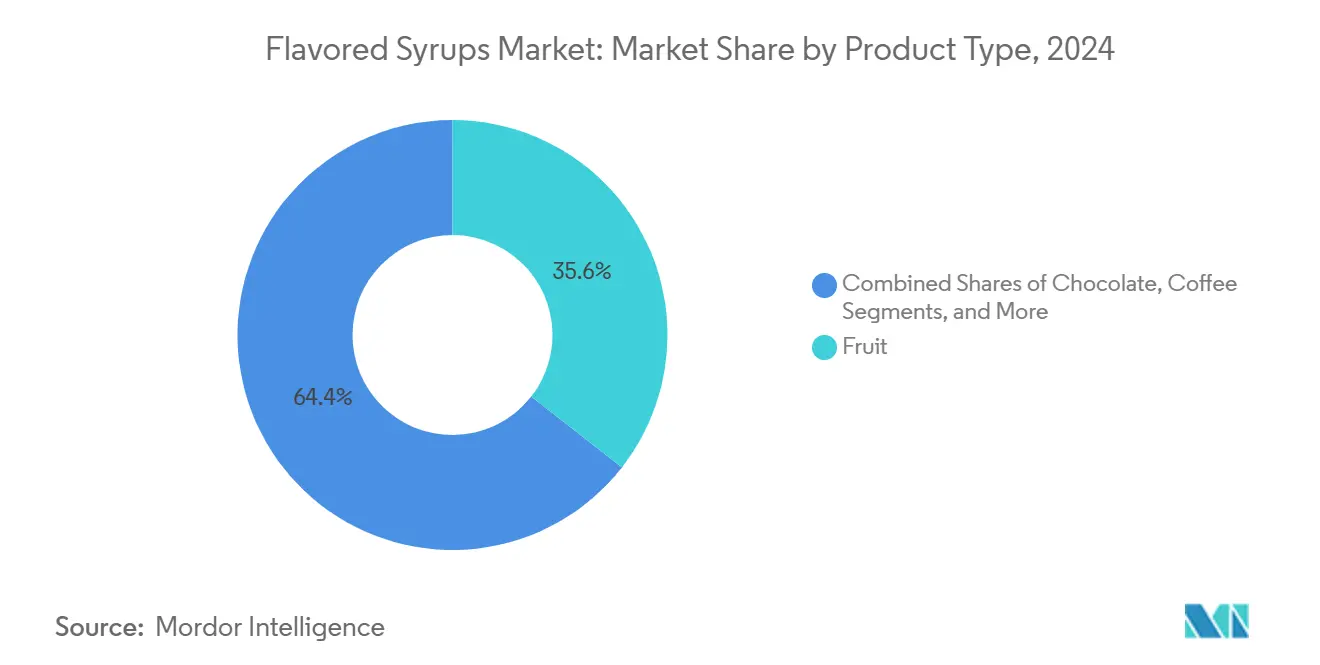
Note: Segment shares of all individual segments available upon report purchase
By Application: Beverage leadership challenged by functional food
In 2024, the beverages segment captures a commanding 36.50% market share, underscoring its status as the leading choice for flavored syrups in coffee shops, restaurants, and retail outlets. This supremacy is bolstered by a well-established foodservice infrastructure and a consumer base that has warmly embraced flavored beverages. Meanwhile, the bakery and confectionery sectors enjoy consistent demand for traditional desserts. Dairy products, on the other hand, are reaping rewards from innovative premium ice creams and yogurts that tap into exotic flavor trends. The "Others" category, encompassing breakfast cereals, desserts, and ready-to-eat meals, sees growth potential through flavor innovations and cross-category developments.
Functional foods are set to be the fastest-growing segment, projected at a 6.34% CAGR from 2025 to 2030. This surge is fueled by a rising consumer focus on health and the blending of nutrition with indulgence. This trend mirrors the broader expansion of the functional beverage market, especially in the Asia-Pacific region, where drinks aimed at immune support dominate and forecast robust growth. Austria Juice's foray into functional syrups, such as 'Relax' infused with botanicals and 'Immune' featuring ginger, showcases a path of innovation. These products not only command a premium position but also promise tangible health benefits, resonating with consumers' desires for enhanced taste and wellness.
By Distribution Channel: B2B Scale Versus B2C Innovation
In 2024, B2B and foodservice channels command a dominant 54.23% market share, underscoring the advantages of institutional purchasing and a well-established syrup dispensing infrastructure in commercial settings. This channel thrives on volume economics, adeptly catering to large-scale operations. Owing to the rising tourism across the world, the demand for flavored syrups in the foodservice sector is also growing. According to the Office for National Statistics UK[3]Office for National Statistics UK, "Number of overseas resident visits to the United Kingdom", www.ons.govdata from 2023, 38 million overseas residents visited the United Kingdom in 2023. Technological advancements bolster the foodservice channel, with innovative dispensing systems like Coca-Cola's Freestyle and Pepsi's Spire offering customization without compromising efficiency. Yet, this channel grapples with margin pressures, facing rising operational costs. Factors like climate change-induced coffee bean price hikes and labor cost inflation are tightening profitability across the foodservice landscape.
B2C channels are the fastest-growing distribution segment, with a 7.12% CAGR from 2025 to 2030, driven by e-commerce expansion and premium positioning strategies. Online platforms lead growth through convenience and product discovery, while specialty stores benefit from experiential retail. Supermarkets and hypermarkets maintain volume leadership, and convenience stores capture impulse purchases. Subscription models and personalized flavor experiences further enhance growth by leveraging consumer data for loyalty and premium pricing.
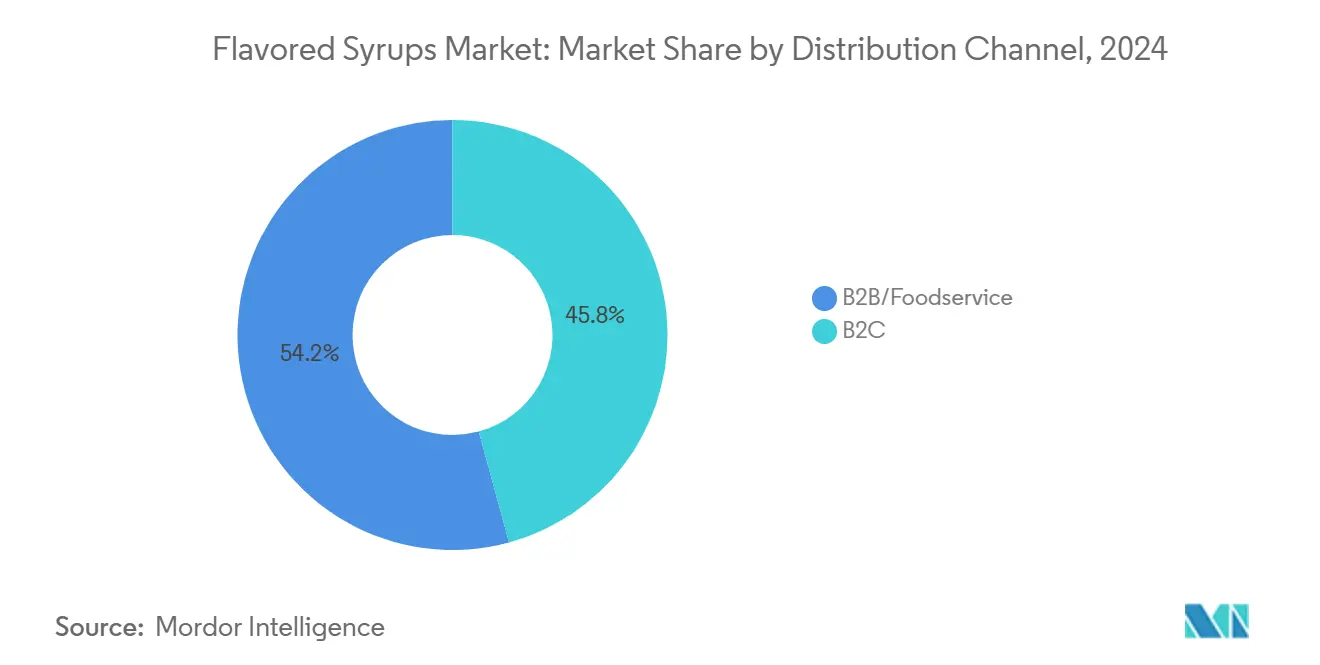
Geography Analysis
In 2024, North America leads the market with a 34.56% share, buoyed by its entrenched coffee culture, a well-established foodservice infrastructure, and consumers' readiness to pay a premium for tailored flavor experiences. Canada and Mexico bolster the region's growth, thanks to their expanding foodservice sectors and robust cross-border trade ties. Additionally, efforts to harmonize regulations are smoothing the path for established players to access the market.
Key European markets, including Germany, France, the UK, Netherlands, Belgium, and Poland, are reaping the benefits of their expansive food industries. Growing health consciousness among consumers is fueling the demand for clean-label products. With a heightened focus on sustainability, manufacturers showcasing environmental responsibility find ample opportunities. Trends like a preference for locally sourced ingredients and a push to minimize packaging waste are shaping purchasing choices. A notable move in this landscape is Argos Wityu's acquisition of Groupe Routin, a premium syrup maker from France, underscoring the industry's tilt towards premium positioning and a focus on natural ingredients.
Asia-Pacific stands out as the region with the fastest growth rate, projected at a 6.45% CAGR from 2025 to 2030. This surge is largely attributed to a burgeoning middle class, a shift towards Western beverage preferences, and swift urbanization. In China, the market is thriving on a surge in coffee consumption and the embrace of Western café culture. Meanwhile, Japan's established market is pioneering innovations in premium and functional beverage applications. The region's booming functional beverage sector, led by a surge in immune-support drinks, presents a golden opportunity for syrup producers. Trends in Australia reveal a shift: 79% of consumers are cutting back on meat, and there's a rising fascination with Southeast Asian flavors. This evolution leans towards plant-based preferences and a taste for exotic flavors. Meanwhile, South America, the Middle East, and Africa are emerging as regions of interest, each charting its own growth path, shaped by economic progress, urbanization, and a warming up to Western beverage styles.
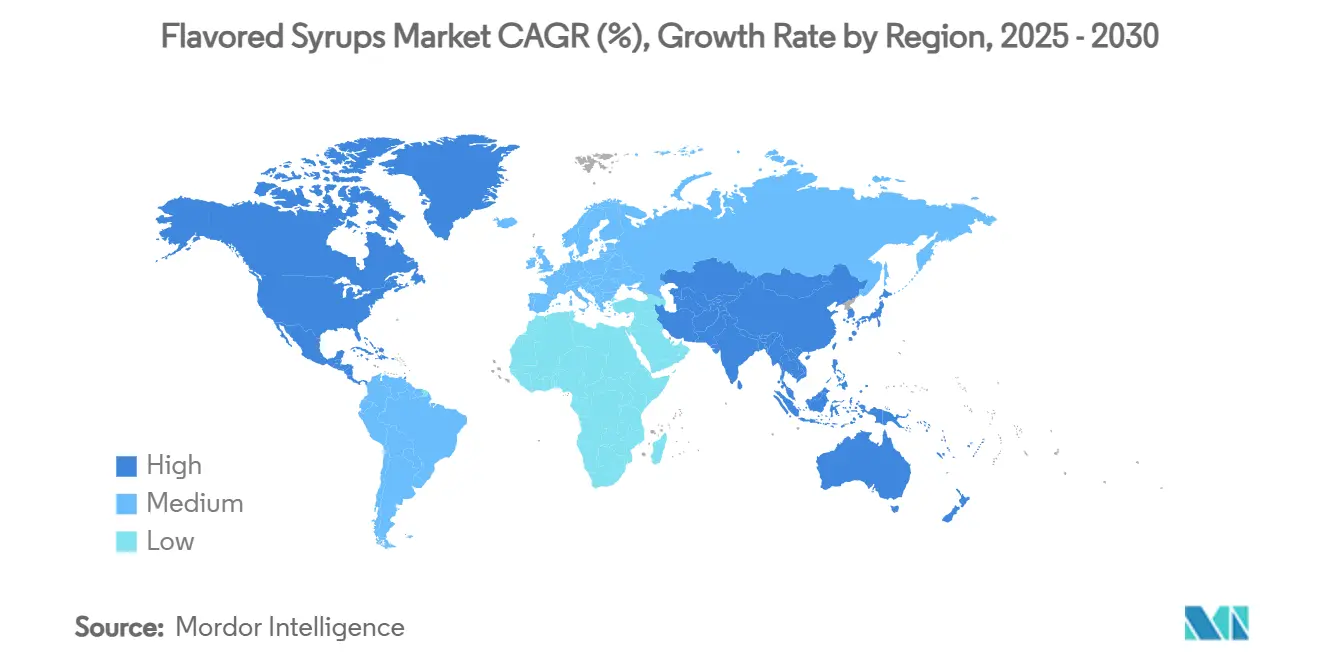
Competitive Landscape
The flavored syrups market showcases a balanced competition. This indicates a tug-of-war between established multinationals and niche regional players. Recent moves, like Glanbia's USD 300 million takeover of Flavor Producers and Tate & Lyle's eyeing of CP Kelco with a proposed USD 1.8 billion deal, spotlight strategic trends. Players are leaning into vertical integration, carving out premium market positions, and emphasizing natural ingredients. Companies are also differentiating through innovation. For instance, Givaudan, with a reported USD 9.30 billion in 2024 sales, attributes its success to robust R&D and collaborative customer engagements. Meanwhile, dsm-firmenich is channeling merger-derived synergies, aiming for an annual USD 409.98 million boost to fuel its innovation drive.
There's a budding interest in functional applications and sustainable sourcing. Monin's 74-acre biodynamic yuzu orchard is a testament to vertical integration, ensuring top-notch ingredients while championing sustainability. Tech is reshaping the landscape, with AI at the helm for flavor crafting and streamlining operations. Notably, 40% of consumers now prioritize taste in vegan offerings, and there's a 23% uptick in product launches spotlighting 'fantasy' flavors. These trends highlight the growing importance of aligning product development with evolving consumer preferences and sustainability narratives.
New-age disruptors are carving niches via direct-to-consumer models and tailored experiences. In contrast, industry stalwarts are leveraging their scale and regulatory know-how to fortify their market positions, creating hurdles for smaller entrants. As the competitive terrain shifts, the winners will be those who adeptly juggle innovation with operational savvy, all while steering through supply chain challenges and regulatory mazes. Companies that can balance these factors effectively are likely to maintain a competitive edge in the evolving flavored syrups market.
Flavored Syrups Industry Leaders
-
Monin Inc.
-
Torani Co.
-
Maison Routin 1883
-
Sensient Technologies Corp.
-
Kerry Group plc
- *Disclaimer: Major Players sorted in no particular order
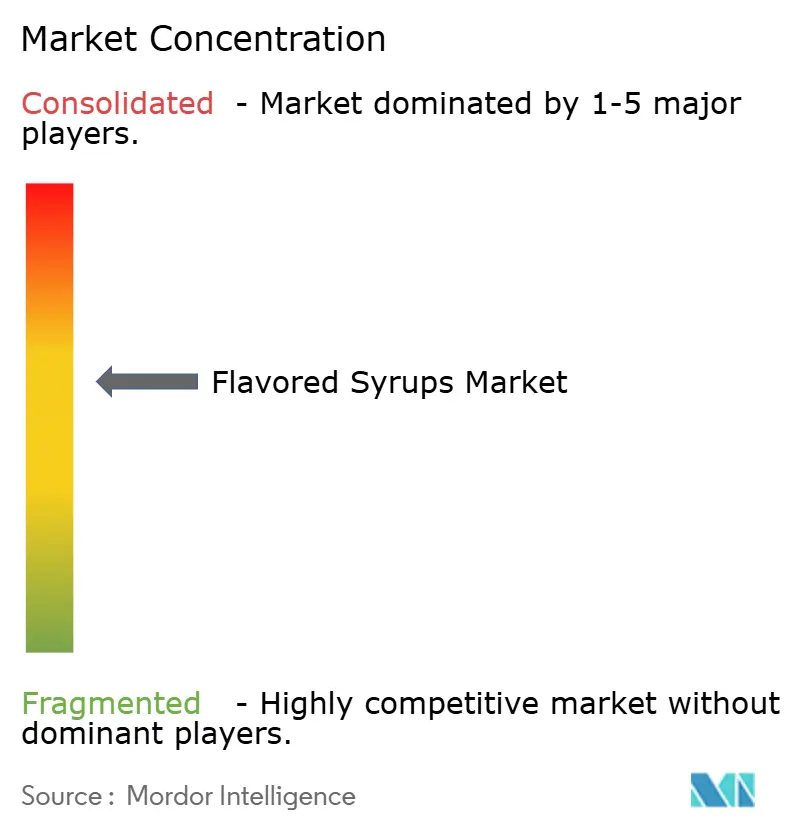
Recent Industry Developments
- June 2025: Zone Syrups launched three new syrup flavors: lavender, bubblegum, and popcorn. The products are made for the cafe, quick-service restaurants, bars, and other foodservice channels. these flavors are added in soda, milkshakes, and other drinks.
- June 2025: Food Service India Pvt Ltd (FSIPL), a prominent player in India's B2B food solutions market, launched a new range of syrups through its brand Marimbula: Jallab, Aam Panna, and Kala Katta. These new syrups are designed to enhance FSIPL's seasonal offerings for hotels, restaurants, cafés, and cloud kitchens nationwide.
- March 2025: Monin Americas, a frontrunner in premium flavor solutions, has introduced its newest creation: Yuzu Pineapple Syrup. Crafted from fruits cultivated by Monin, this syrup melds the distinctive tart and floral notes of yuzu with the sweet and tangy essence of pineapple. The result is a premium tropical flavor, perfect for enhancing cocktails, teas, and culinary dishes.
- November 2024: 5 to go, a Romanian brand, has introduced a limited-edition Dubai chocolate coffee syrup. Referred to as The Choco Pistachio, this Dubai Chocolate Flavour Edition syrup combines the refined flavors of chocolate and pistachio, inspired by the brand's renowned Makalu Shisha syrup recipe.
Global Flavored Syrups Market Report Scope
| Fruits |
| Chocolate |
| Herbs and Botanicals |
| Coffee |
| Others (Malt, Vanilla, Almond, Coconut) |
| Beverages |
| Bakery and Confectionery |
| Dairy Products |
| Functional Foods |
| Others(Breakfast Cereals, Desserts, RTE Foods) |
| B2B/Foodservice | |
| B2C | Supermarkets/Hypermarkets |
| Convenience Stores | |
| Specialty Stores | |
| Online Channels | |
| Other Distribution channels |
| North America | United States |
| Canada | |
| Mexico | |
| Rest of North America | |
| Europe | Germany |
| United Kingdom | |
| Italy | |
| France | |
| Spain | |
| Netherlands | |
| Poland | |
| Belgium | |
| Sweden | |
| Rest of Europe | |
| Asia-Pacific | China |
| India | |
| Japan | |
| Australia | |
| Indonesia | |
| South Korea | |
| Thailand | |
| Singapore | |
| Rest of Asia-Pacific | |
| South America | Brazil |
| Argentina | |
| Colombia | |
| Chile | |
| Peru | |
| Rest of South America | |
| Middle East and Africa | South Africa |
| Saudi Arabia | |
| United Arab Emirates | |
| Nigeria | |
| Egypt | |
| Morocco | |
| Turkey | |
| Rest of Middle East and Africa |
| Product Type | Fruits | |
| Chocolate | ||
| Herbs and Botanicals | ||
| Coffee | ||
| Others (Malt, Vanilla, Almond, Coconut) | ||
| Application | Beverages | |
| Bakery and Confectionery | ||
| Dairy Products | ||
| Functional Foods | ||
| Others(Breakfast Cereals, Desserts, RTE Foods) | ||
| Distribution Channels | B2B/Foodservice | |
| B2C | Supermarkets/Hypermarkets | |
| Convenience Stores | ||
| Specialty Stores | ||
| Online Channels | ||
| Other Distribution channels | ||
| Geography | North America | United States |
| Canada | ||
| Mexico | ||
| Rest of North America | ||
| Europe | Germany | |
| United Kingdom | ||
| Italy | ||
| France | ||
| Spain | ||
| Netherlands | ||
| Poland | ||
| Belgium | ||
| Sweden | ||
| Rest of Europe | ||
| Asia-Pacific | China | |
| India | ||
| Japan | ||
| Australia | ||
| Indonesia | ||
| South Korea | ||
| Thailand | ||
| Singapore | ||
| Rest of Asia-Pacific | ||
| South America | Brazil | |
| Argentina | ||
| Colombia | ||
| Chile | ||
| Peru | ||
| Rest of South America | ||
| Middle East and Africa | South Africa | |
| Saudi Arabia | ||
| United Arab Emirates | ||
| Nigeria | ||
| Egypt | ||
| Morocco | ||
| Turkey | ||
| Rest of Middle East and Africa | ||
Key Questions Answered in the Report
How large is the flavored syrups market in 2025?
The flavored syrups market size stands at USD 65.21 billion in 2025.
Which product category holds the highest share?
Fruit-based syrups lead with 35.56% flavored syrups market share in 2024.
What region is growing fastest?
Asia-Pacific is expected to log a 6.45% CAGR between 2025 and 2030.
Which application segment shows the strongest future growth?
Functional foods are projected to expand at 6.34% CAGR through 2030.
Page last updated on:
